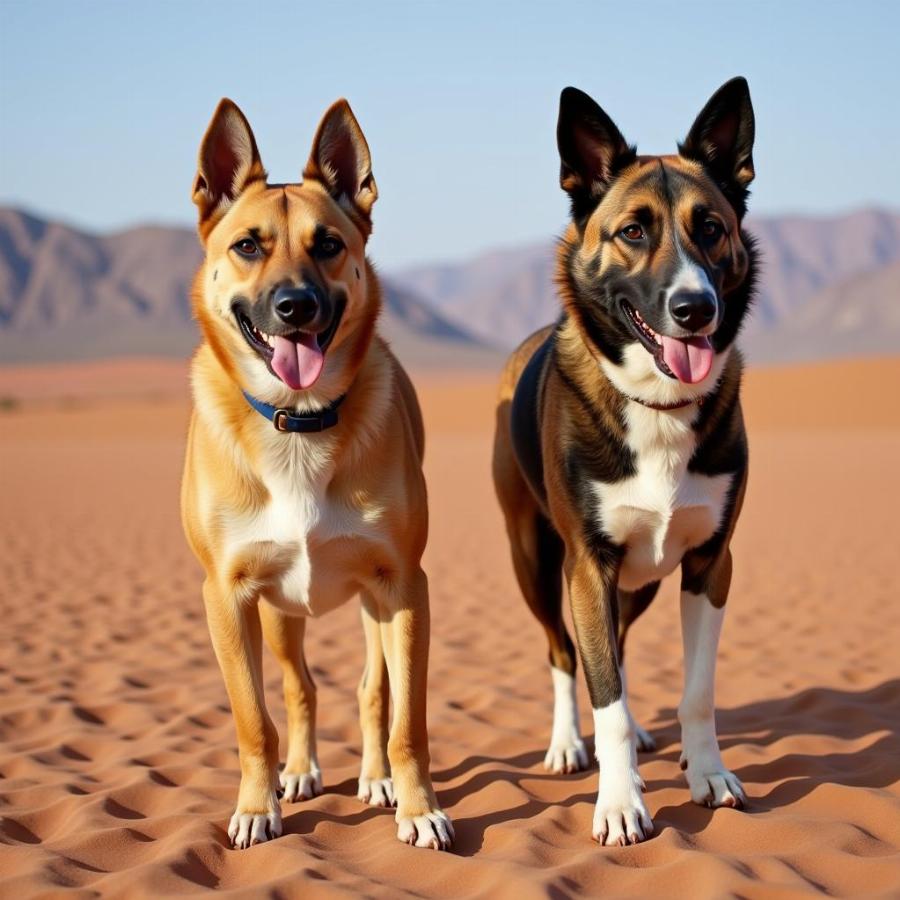Navigating the desert’s unique challenges with a canine companion requires careful planning and consideration. A guide dog in a desert environment faces different obstacles than those in urban settings, from extreme temperatures to navigating sandy terrain. This comprehensive guide explores the crucial aspects of ensuring your guide dog’s safety and well-being in arid climates.
Choosing the Right Breed for Desert Life
Not all breeds are suited for the harsh desert climate. A dog with a thick, double coat will overheat quickly. Consider breeds like the Canaan Dog or the Australian Cattle Dog, known for their adaptability to hotter climates. Their shorter coats and inherent resilience make them better equipped to handle the desert heat.  Desert-Adapted Dog Breeds: Canaan Dog and Australian Cattle Dog
Desert-Adapted Dog Breeds: Canaan Dog and Australian Cattle Dog
Protecting Your Guide Dog from the Heat
The desert sun can be unforgiving. Provide ample shade and water for your guide dog. Portable water bowls and shaded rest stops are essential during travels. Avoid walking your dog during the hottest parts of the day. Early mornings and evenings are the safest times. Even then, be mindful of the temperature of the ground, which can burn their paws.
What are the signs of heatstroke in dogs?
Excessive panting, drooling, weakness, and vomiting are all signs of heatstroke. If you observe these symptoms, immediately seek veterinary attention.
Navigating Sandy Terrain
Sand can be challenging for guide dogs. It can get in their eyes, paws, and even cause sand impaction if ingested. Protective booties can help prevent paw irritation and burns. Regularly check your dog’s eyes and ears for sand accumulation. For more information on sand-related issues, see our article on sand impaction in dogs.
How can I prevent sand impaction in my dog?
Discourage your dog from eating sand by providing plenty of fresh water and avoiding areas with loose, dry sand. If you suspect sand impaction, consult a veterinarian.
Training Your Guide Dog for Desert Conditions
Training your guide dog for the desert requires specific adaptations. Familiarize them with the terrain and potential hazards like cacti and wildlife. Reinforce basic commands and ensure they respond reliably even in distracting environments. Similar to training for urban environments, positive reinforcement techniques are crucial. You might also be interested in learning about the African sand dog.
Essential Gear for Desert Guide Dogs
Investing in appropriate gear is vital. Cooling vests, lightweight harnesses, and collapsible water bowls are invaluable. Protective eyewear can shield their eyes from the sun and sand. For tips on dog-friendly accommodations in desert areas, check out our guide to hotels palm desert dog friendly.
What kind of harness is best for a guide dog in the desert?
A lightweight, breathable harness is essential. Avoid harnesses made of materials that retain heat.
Dr. Emily Carter, DVM, on Desert Dog Care
“Desert environments present unique challenges for guide dogs. Owners must be proactive in protecting their companions from the heat and ensuring their overall well-being.”
John Davis, Certified Dog Trainer, on Desert Training:
“Adapting training techniques to the desert landscape is crucial. Focus on reinforcing commands in distracting environments and introducing your dog to potential hazards gradually.”
Conclusion
Bringing your guide dog to the desert requires careful preparation and ongoing attention to their needs. By understanding the specific challenges of this environment and taking the necessary precautions, you can ensure your guide dog remains safe, healthy, and happy while navigating the desert landscape. Remember to prioritize their comfort and safety, and always consult with a veterinarian if you have any concerns.
FAQs
- Can any dog breed be a guide dog in the desert? No, not all breeds are suitable for the desert. Short-coated breeds adapted to hotter climates are generally preferred.
- What is the most important thing to consider when taking a guide dog to the desert? Providing adequate shade and water is paramount to prevent heatstroke.
- How can I protect my dog’s paws from the hot sand? Dog booties can help protect their paws from burns and irritation.
- What are the signs of sand impaction? Vomiting, constipation, and lethargy can indicate sand impaction.
- How can I train my guide dog for desert conditions? Familiarize them with the terrain, reinforce commands in distracting environments, and introduce them to potential hazards gradually.
You may also be interested in learning more about dogs in Las Vegas with our articles about dog new vegas and new vegas dog.
Beaut Dogs is your trusted source for comprehensive information on all aspects of dog ownership, specializing in show dogs. We offer expert advice, breed-specific guides, and valuable resources to help you provide the best possible care for your canine companion. For personalized support and detailed answers to your dog care questions, please contact us via Email: [email protected]. We are here to help!